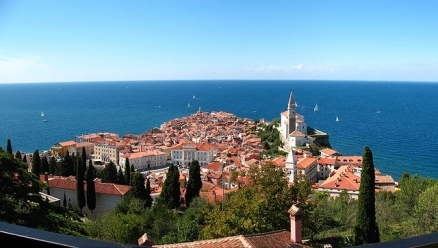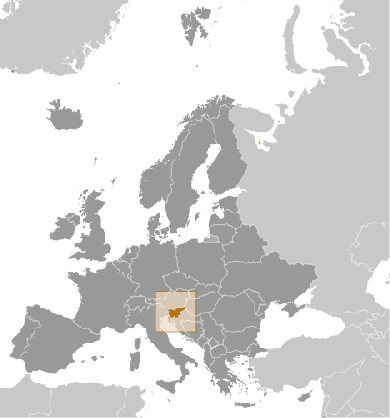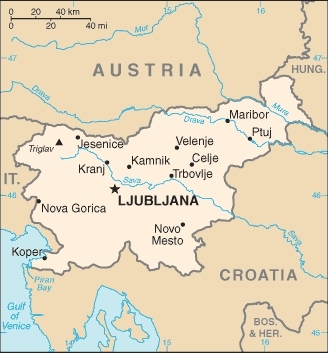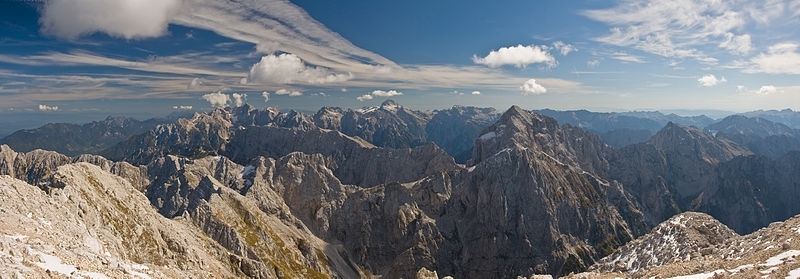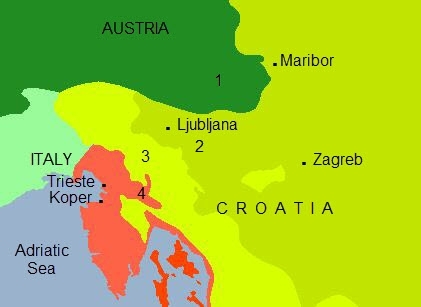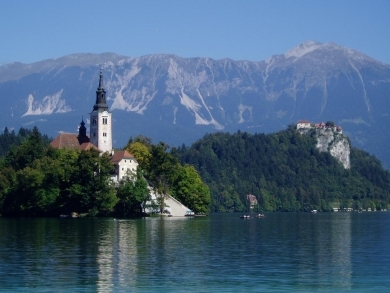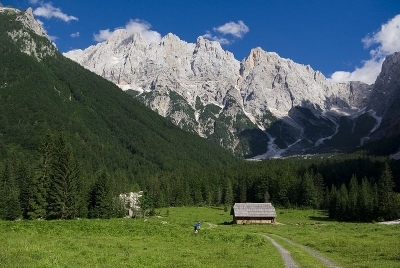Slovenia
Countries and Regions of the World Collection  Slovenia is a nation of two million people in south Central Europe, between Austria and Croatia.
Slovenia is a nation of two million people in south Central Europe, between Austria and Croatia.
It includes a short coastal strip on the Adriatic, an alpine mountain region (Julian Alps) adjacent to Italy and Austria, and mixed mountains and valleys with numerous rivers to the east.
Its major environmental issues include:
- Sava River polluted with domestic and industrial waste;
- pollution of coastal waters with heavy metals and toxic chemicals; and,
- forest damage near Koper from air pollution (originating at metallurgical and chemical plants) and resulting acid rain
Slovenia is susceptible to flooding and earthquakes.
The Slovene lands were part of the Austro-Hungarian Empire until the latter's dissolution at the end of World War I.
In 1918, the Slovenes joined the Serbs and Croats in forming a new multinational state, which was named Yugoslavia in 1929.
After World War II, Slovenia became a republic of the renewed Yugoslavia, which though Communist, distanced itself from Moscow's rule.
Dissatisfied with the exercise of power by the majority Serbs, the Slovenes succeeded in establishing their independence in 1991 after a short 10-day war.
Historical ties to Western Europe, a strong economy, and a stable democracy have assisted in Slovenia's transformation to a modern state. Slovenia acceded to both NATO and the European Union in the spring of 2004; it joined the eurozone in 2007.
Despite its small size, this eastern Alpine country controls some of Europe's major transit routes.
Contents
Geography
Slovenia is situated at the crossroads of central Europe, the Mediterranean, and the Balkans. The Alps--including the Julian Alps, the Kamnik-Savinja Alps, the Karavanke chain, and the Pohorje Massif--dominate northern Slovenia near Austria. Slovenia's Adriatic coastline extends for approximately 48 kilometers (30 mi.) from Italy to Croatia. The term "karst"--a limestone region of underground rivers, sinkholes, and caves--originated in Slovenia's Karst plateau between Ljubljana and the Italian border. On the Pannonian plain to the east and northeast, toward the Croatian and Hungarian borders, the landscape is essentially flat. However, the majority of Slovenian terrain is hilly or mountainous, with around 90% of the surface 200 meters or more above sea level.
Location: south Central Europe, Julian Alps between Austria and Croatia
Geographic Coordinates: 46 07 N, 14 49 E
Area: 20,273 sq km (land: 20,151 sq km; water: 122 sq km}
Land Boundaries: 1,086 km (Austria 330 km, Croatia 455 km, Hungary 102 km, Italy 199 km.
As a member state that forms part of the EU's external border, Slovenia has implemented the strict Schengen border rules to curb illegal migration and commerce through southeastern Europe while encouraging close cross-border ties with Croatia.
Coastline: 46.6 km
Maritime Claims: territorial sea: 12 nm
The Croatia-Slovenia land and maritime boundary agreement, which would have ceded most of Piran Bay and maritime access to Slovenia and several villages to Croatia, remains unratified and in dispute; Slovenia also protests Croatia's 2003 claim to an exclusive economic zone in the Adriatic.
Natural Hazards: flooding; earthquakes
Terrain: a short coastal strip on the Adriatic, an alpine mountain region adjacent to Italy and Austria, mixed mountains and valleys with numerous rivers to the east. The highest point is Triglav (2,864 m).
Climate: Mediterranean climate on the coast, continental climate with mild to hot summers and cold winters in the plateaus and valleys to the east
View from top of the Mangart (2679m) to Triglav National Park. Triglav (2864m), the highest mountain in Slovenia is seen in the background in the middle of the image. Panorama stitched from three landscape format images using PTGUI. Source: Wikimedia Commons.
Ecology and Biodiversity1. Alps conifer and mixed forests 2. Pannonian mixed forests 3. Dinaric Mountains mixed forests 4. Illyrian deciduous forests Map source: world Wildlife Fund See also:
|
People and Society
Population: 1,996,617 (July 2012 est.)
The majority of Slovenia's population is Slovene (over 83%). Hungarians and Italians have the status of indigenous minorities under the Slovenian constitution, which guarantees them seats in the National Assembly. Most other minority groups, particularly those from the former Yugoslavia, immigrated after World War II for economic reasons. Slovenes are predominantly Roman Catholic, though the country also has a small number of Protestants, Orthodox Christians, Muslims, and Jews. Slovene is a Slavic language, written in the Roman script.
Ethnic Groups: Slovene 83.1%, Serb 2%, Croat 1.8%, Bosniak 1.1%, other or unspecified 12% (2002 census).
| Lake Bled in Slovenia, with the Church of the Assumption at the left on little Bled Island, Bled Castle atop the cliffs on the right, and the Julian Alps towering in the background. |
| Alpine valley of Krnica near Kranjska Gora, Slovenia. The highest peak (in the clouds) in the picture is Škrlatica. Source: Wikimedia Commons. |
| Cerknica Lake Poljé. Source: Sylaf/Flickr |
Age Structure:
0-14 years: 13.4% (male 138,604/female 130,337)
15-64 years: 69.8% (male 703,374/female 692,640)
65 years and over: 16.8% (male 132,069/female 203,068) (2011 est.)
Population Growth Rate: -0.185% (2012 est.)
Birthrate: 8.76 births/1,000 population (2012 est.)
Death Rate: 11 deaths/1,000 population (July 2012 est.)
Net Migration Rate: 0.39 migrant(s)/1,000 population (2012 est.)
Life Expectancy at Birth: 77.48 years
male: 73.83 years
female: 81.36 years (2012 est.)
Total Fertility Rate: 1.31 children born/woman (2012 est.)
Languages: Slovenian (official) 91.1%, Serbo-Croatian 4.5%, other or unspecified 4.4%, Italian (official, only in municipalities where Italian national communities reside, Hungarian (official, only in municipalities where Hungarian national communities reside (2002 census)
Literacy: 99.6% (2000 est.)
Urbanization: 50% of total population (2010) growing at an annual rate of change of 0.2% (2010-15 est.)
History
Slovenia is today a vibrant democracy, but the roots of this democracy go back deep in Slovene history. According to the 16th-century French political philosopher, Jean Bodin, Slovenes practiced the unique custom of the Installation of the Dukes of Carinthia for almost 1,000 years, until the late 14th century. According to some scholars, Bodin's account of how Slovene farmers contractually consented to be governed by the Duke influenced Thomas Jefferson's drafting of the Declaration of Independence. From as early as the 9th century, Slovenia had fallen under foreign rulers, including partial control by Bavarian dukes and the Republic of Venice. With the exception of Napoleon's 4-year tutelage of parts of Slovenia and Croatia--the "Illyrian Provinces"--Slovenia was part of the Habsburg Empire from the 14th century until 1918. Nevertheless, Slovenia resisted Germanizing influences and retained its unique Slavic language and culture.
In 1918, Slovenia joined with other southern Slav states in forming the Kingdom of Serbs, Croats, and Slovenes as part of the peace plan at the end of World War I. Renamed in 1929 under a Serbian monarch, the Kingdom of Yugoslavia fell to the Axis powers during World War II. Following communist partisan resistance to German, Hungarian, and Italian occupation and elimination of rival resistance groups, socialist Yugoslavia was born under the helm of Josip Broz Tito. During the communist era, Slovenia became Yugoslavia's most prosperous republic, at the forefront of Yugoslavia's unique version of communism. Within a few years of Tito's death in 1980, Belgrade initiated plans to further concentrate political and economic power in its hands. Defying the politicians in Belgrade, Slovenia underwent a flowering of democracy and an opening of its society in cultural, civic, and economic realms to a degree almost unprecedented in the communist world. In September 1989, the General Assembly of the Yugoslav Republic of Slovenia adopted an amendment to its constitution asserting Slovenia's right to secede from Yugoslavia. On December 23, 1990, 88% of Slovenia's population voted for independence in a referendum, and on June 25, 1991, the Republic of Slovenia declared its independence. A nearly bloodless 10-day war with Yugoslavia followed. Yugoslav forces withdrew after Slovenia demonstrated stiff resistance to Belgrade.
Slovenia's first President, Milan Kucan, concluded his second and final term in December 2002. Former Prime Minister Janez Drnovsek defeated opposition candidate Barbara Brezigar in the 2002 presidential elections by a comfortable margin and was inaugurated as Kucan's successor on December 22, 2002. In November 2007 elections, Danilo Turk succeeded Janez Drnovsek as President of the Republic of Slovenia with 68% of the vote. In the October 2004 election, Janez Jansa became prime minister after his center-right Slovenian Democratic Party (SDS) won a relative majority with over 29% of the vote. Parliamentary elections in September 2008 brought a new center-left coalition to power, with Borut Pahor, head of the Social Democrats, replacing Jansa as prime minister in November 2008. Following the gradual collapse of Pahor’s ruling coalition and the loss of a vote of confidence in his government in September 2011, Slovenia held national parliamentary elections on December 4, 2011. Former Ljubljana mayor Zoran Jankovic’s party won the election, but Jankovic did not secure sufficient votes to become the Prime Minister. On January 28, 2012, former Prime Minister Janez Jansa returned to power through a coalition government. New ministers were confirmed by parliament on February 10, 2012.
The government and most of the Slovenian polity share a common view of the desirability of a close association with the West, specifically of membership in both the EU and NATO. For all the apparent bitterness that divides left and right wings, there are few fundamental philosophical differences between them in the area of public policy. Slovenian society is built on consensus, which has converged on a social-democrat model. Political differences tend to have their roots in the roles that groups and individuals played during the years of communist rule and the struggle for independence.
Since independence in 1991, Slovenia has made great progress in establishing democratic institutions, enshrining respect for human rights, establishing a market economy, and adapting its military to Western norms and standards. In contrast to its southern neighbors, civil tranquility has marked this period, with strong economic growth for much of that time. Upon achieving independence, Slovenia offered citizenship to all residents, regardless of ethnicity or origin, avoiding sectarian complications seen in some central European countries. However, debate continued on how best to accommodate an estimated 25,000 undocumented non-Slovenes who were resident in Slovenia at the time of independence, but whose records were "erased" when they did not take citizenship. Many in this group regularized their status or left the country, but it was estimated that about 4,000 cases remained unresolved. In March 2010, Parliament passed a law granting permanent residency status to those 4,000 that is retroactive to the date of erasure (February 1992). Slovenia accepted nearly 100,000 refugees from the fighting in Bosnia and has since participated in international stabilization efforts in the region.
As a young independent republic, Slovenia pursued economic stabilization and further political openness while emphasizing its Western outlook and central European heritage. Today Slovenia is a stable democracy with a growing regional profile. It has increased its international engagement, playing a significant role relative to its size. Slovenia became a member of the North Atlantic Treaty Organization (NATO) and the European Union (EU) in 2004.
Government
Government Type: Parliamentary republic
Since the breakup of the former Yugoslavia, Slovenia has instituted a stable, multi-party, democratic political system, characterized by regular elections, a free press, and an excellent human rights record. Slovenia is a parliamentary democracy and constitutional republic. Within its government, power is shared between a directly elected president, a prime minister, and a bicameral legislature (Parliament). Parliament is composed of the 90-member National Assembly--which takes the lead on virtually all legislative issues--and the National Council, a largely advisory body composed of representatives from social, economic, professional, and local interests. The Constitutional Court has the highest power of review of legislation to ensure its consistency with Slovenia's constitution. Its nine judges are elected by the National Assembly for a single 9-year term.
Capital: Ljubljana - 260,000 (2009)

View from the Ljubljana Castle towards the north. Source: Wikimedia Commons.
Administrative divisions: 200 municipalities (obcine, singular - obcina) and 11 urban municipalities (mestne obcine, singular - mestna obcina)
Independence Date: 25 June 1991 (from Yugoslavia)
Legal System: civil law system. Slovenia has not submitted an International Court of Justice (ICJ) jurisdiction declaration; but, accepts International criminal court (ICCt) jurisdiction
International Environmental Agreements
Slovenia is party to international agreements on: Air Pollution, Air Pollution-Nitrogen Oxides, Air Pollution-Persistent Organic Pollutants, Air Pollution-Sulfur 94, Biodiversity, Climate Change, Climate Change-Kyoto Protocol, Desertification, Endangered Species, Environmental Modification, Hazardous Wastes, Law of the Sea, Marine Dumping, Ozone Layer Protection, Ship Pollution, Wetlands, and Whaling.
Water
Total Renewable Water Resources: 32.1 cu km (2005)
Freshwater Withdrawal: 0.9 cu km/year
Per Capita Freshwater Withdrawal: 457 cu m/yr (2002)
Agriculture
Agricultural products: potatoes, hops, wheat, sugar beets, corn, grapes; cattle, sheep, poultry
Irrigated Land: 100 sq km (2008)
Resources
Natural Resources: lignite coal, lead, zinc, building stone, hydropower, forests
Land Use:
Economy
As the most prosperous republic of the former Yugoslavia, Slovenia emerged from its brief 10-day war of secession in 1991 as an independent nation for the first time in its history. Since that time, the country has made steady but cautious progress toward developing a market economy. Economic reforms introduced shortly after independence led to healthy economic growth. Slovenia's economy has benefited from the country's embrace of liberal trade, following the rule of law, and rewarding enterprise. The country has a well-educated and productive work force as well as dynamic and effective political and economic institutions. Despite recent declines in GDP growth, Slovenia has been one the best economic performers in central and eastern Europe, with a 2009 GDP per capita of $23,800. In light of the global economic crisis, the government has introduced measures to shore up Slovenian businesses. The biggest influence on the Slovene economy for 2011 was the ability of Slovenia’s export markets, notably Germany, to recover quickly from the recession.
Slovenia already enjoyed a relatively prosperous economy and strong market ties to the West when it gained independence in 1991. Although it comprised only about one-thirteenth of Yugoslavia's total population, Slovenia was the most productive of the Yugoslav republics, accounting for one-fifth of its GDP and one-third of its exports. Since independence, Slovenia has pursued diversification of its trade toward the West and integration into Western and transatlantic institutions vigorously, becoming party to a number of bilateral and regional free trade agreements. Slovenia is a founding member of the World Trade Organization (WTO) and joined the Central European Free Trade Agreement (CEFTA) in 1996. Slovenia also participates in the Southeast European Cooperative Initiative (SECI), the Central European Initiative, the Royaumont Process, and the Black Sea Economic Council. Slovenia became an EU member state on May 1, 2004 and joined the Euro Zone in January 2007. Slovenia joined the Organization for Economic Cooperation and Development Europe (OECD) in 2010.
Slovenia's economy is highly dependent on foreign trade. About three-quarters of its trade is with the EU, and the vast majority of this is with Germany, Italy, Austria, and France. The country has successfully penetrated the south and east markets, including the former Soviet Union region. This high level of openness makes Slovenia extremely sensitive to economic conditions in its main trading partners and changes in its international price competitiveness. Keeping labor costs in line with productivity is a key challenge for Slovenia's economic well-being.
Gross domestic product growth fell to 3.5% in 2008 after experiencing a growth rate of about 6.1% the prior year. Due to the recession in Slovenia’s export markets, GDP fell by about 7.8% in 2009. Services contributed the most to the national output in 2009, accounting for 61% of GDP. Industry and construction comprised 37% of GDP, and agriculture, forestry, and fishing accounted for 2% of GDP. While the service sector is the largest part of the economy as a percentage of GDP, manufacturing accounts for most employment, with machinery and other manufactured products comprising the major exports. International Labor Organization (ILO) statistics put unemployment at 7% (March 2009). Inflation, after declining from 3.6% in 2004 to 2.5% in 2005 and 2006, returned to 3.6% for 2007, and spiked to 6.4% in 2008, but decreased to 1.8% following the onset of the global economic crisis.
In 2009, the world recession caused the economy to contract - through falling exports and industrial production - by 8%, and unemployment to rise. Although growth resumed in 2010, the unemployment rate continued to rise, approaching 11% in 2011.
Energy is at the forefront in Slovenia today as the government considers how to restructure the sector. Slovenia is becoming increasingly dependent on imports of primary energy sources. In 2008, net imports in gross domestic consumption reached 55.3%. This is primarily due to the demand for fossil fuel for transportation (petroleum products) and heating (natural gas). Electricity production and consumption are more or less balanced in Slovenia. The share of renewables, including hydro power, amounted to roughly 11% of primary energy sources during the last 5 years. According to 2008 figures, Slovenia covers 19% of its energy needs with fossil fuels, 37% with petroleum products, 12% with natural gas, 21% with nuclear energy, 4% with hydro energy, and 7% from renewable sources. In view of domestic sources, nuclear power prevails with 44%, followed by fossil fuels with 32%, hydro energy with 9%, and other renewable sources with 14%. More than 58% of Slovenia’s surface is covered with forests, providing an ample source of renewable energy.
Although Slovenia has taken a cautious, deliberate approach to economic management and reform, with heavy emphasis on achieving consensus before proceeding, its overall record is one of relative success. Economic management in Slovenia is relatively good. That said, the economic crisis of 2008 revealed some of the underlying structural problems with the Slovenian economy. The OECD’s Economic Survey of Slovenia 2011 stressed the urgent need for immediate pension reform, drastic changes in distribution of funds available for education, cancellation of pay increases in the public sector, stress tests for the entire banking sector, and introduction of measures to make Slovenia friendlier to foreign direct investment (FDI) in order to increase productivity, rebalance the national economy, and increase competitiveness.
Due to its macroeconomic stability, favorable foreign debt position, and successful accession to the EU, Slovenia consistently receives the highest credit rating of all transition economies--receiving the top regional honors in a recent Dunn & Bradstreet survey. Slovenia's ability to meet its growth rate objectives will largely depend on the state of the world economy, since export demand in Slovenia's primary market has stalled. Foreign direct investment will take up the slack to some extent, as analysts forecast FDI levels will continue to increase with further privatization of state assets, including portions of the telecommunications, financial, and energy sectors. Slovenia must carefully address fiscal, monetary, and FDI policy, in light of the high deficit in pension accounts, its vulnerable Western export markets, and inflation concerns. Slovenian enterprises have a tradition of market orientation that has served them well in the transition period, as they moved energetically to reorient trade from former Yugoslav markets to those of Central and Eastern Europe. However, in many cases under the Slovenian brand of privatization, managers and workers in formerly "socially owned" enterprises have become the majority shareholders, perpetuating the practices of "worker management" that were the hallmark of the Yugoslav brand of socialism. Difficulties associated with that model are expected to decrease under competitive pressures, as shares in these firms change hands, and as EU reforms introduce more Western-oriented governance practices.
Government efforts and reforms designed to attract foreign direct investment have proven somewhat successful--FDI is continuing to slowly grow. Slovenia's traditional anti-inflation policy in the past relied heavily on capital inflow restrictions. Its slow privatization process favored domestic investors and prescribed long lag time on share trading, complicated by a cultural wariness of being "bought up" by foreigners. As such, Slovenia has had a number of impediments to full foreign participation in its economy. However, a number of these barriers to FDI were fully removed in 2002. Despite these improvements, Slovenia scored poorly in a 2010 World Economic Forum report on FDI openness (116 out of 139 in two categories: prevalence of foreign ownership and rules impacting FDI) and has a relatively low level of FDI in comparison to the region. U.S. investments in Slovenia have been modest; Goodyear is the largest American investor. Even with these successes, much of the economy remains in state hands and foreign direct investment in Slovenia is one of the lowest in the EU on a per capita basis. American companies looking to do business in Slovenia face a challenging environment, particularly if they are interested in selling goods and services to the government. The public procurement process, although compliant with most EU regulations and international treaties, remains opaque and often characterized by favoritism and corruption.
GDP: (Purchasing Power Parity): $58.56 billion (2011 est.)
GDP: (Official Exchange Rate): $52.4 billion (2011 est.)
GDP- per capita (PPP): $29,100 (2011 est.)
GDP- composition by sector:
agriculture: 2.4%
industry: 31.4%
services: 66.2% (2011 est.)
Industries: ferrous metallurgy and aluminum products, lead and zinc smelting; electronics (including military electronics), trucks, automobiles, electric power equipment, wood products, textiles, chemicals, machine tools
Currency: Euros (EUR)
